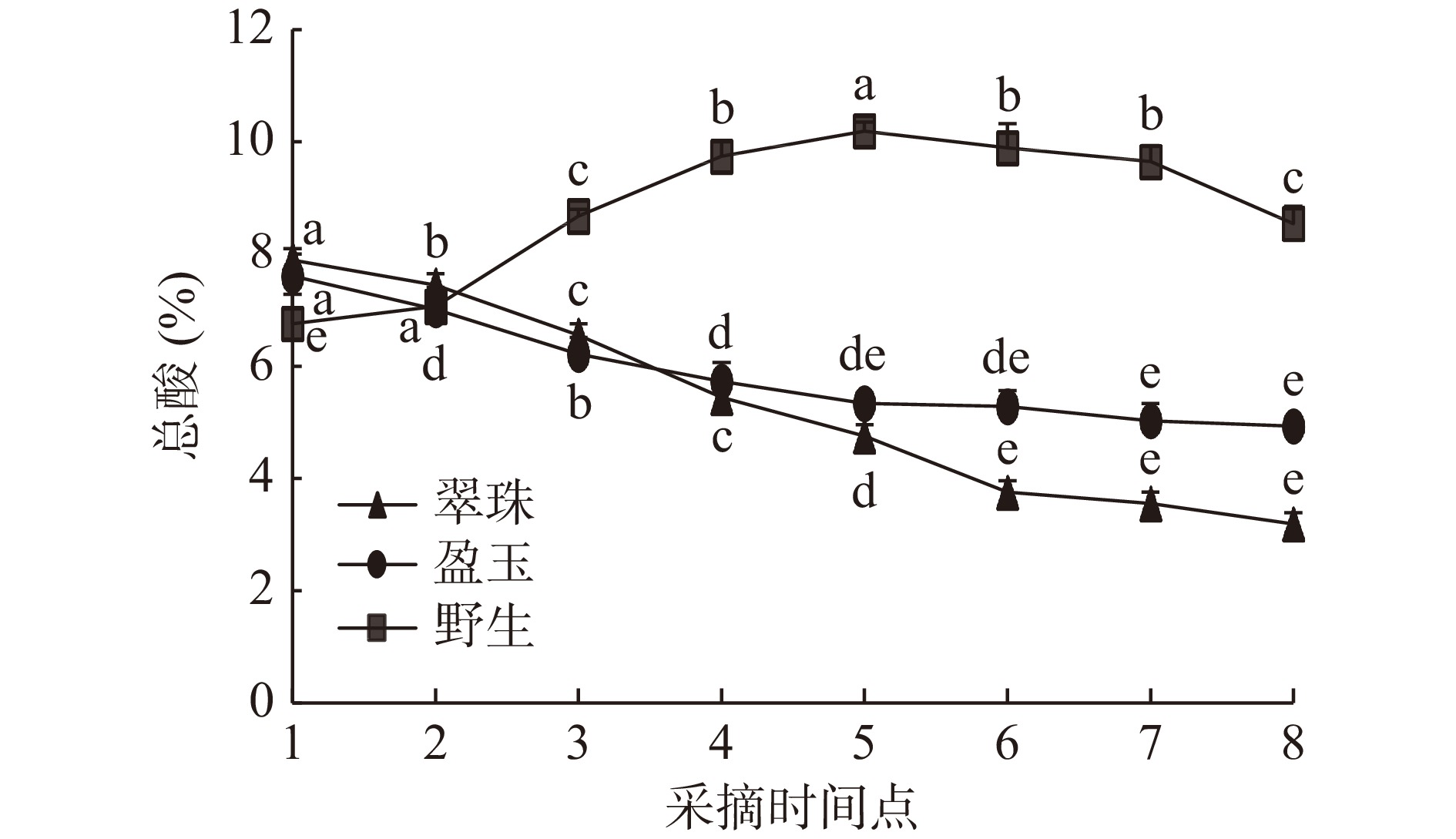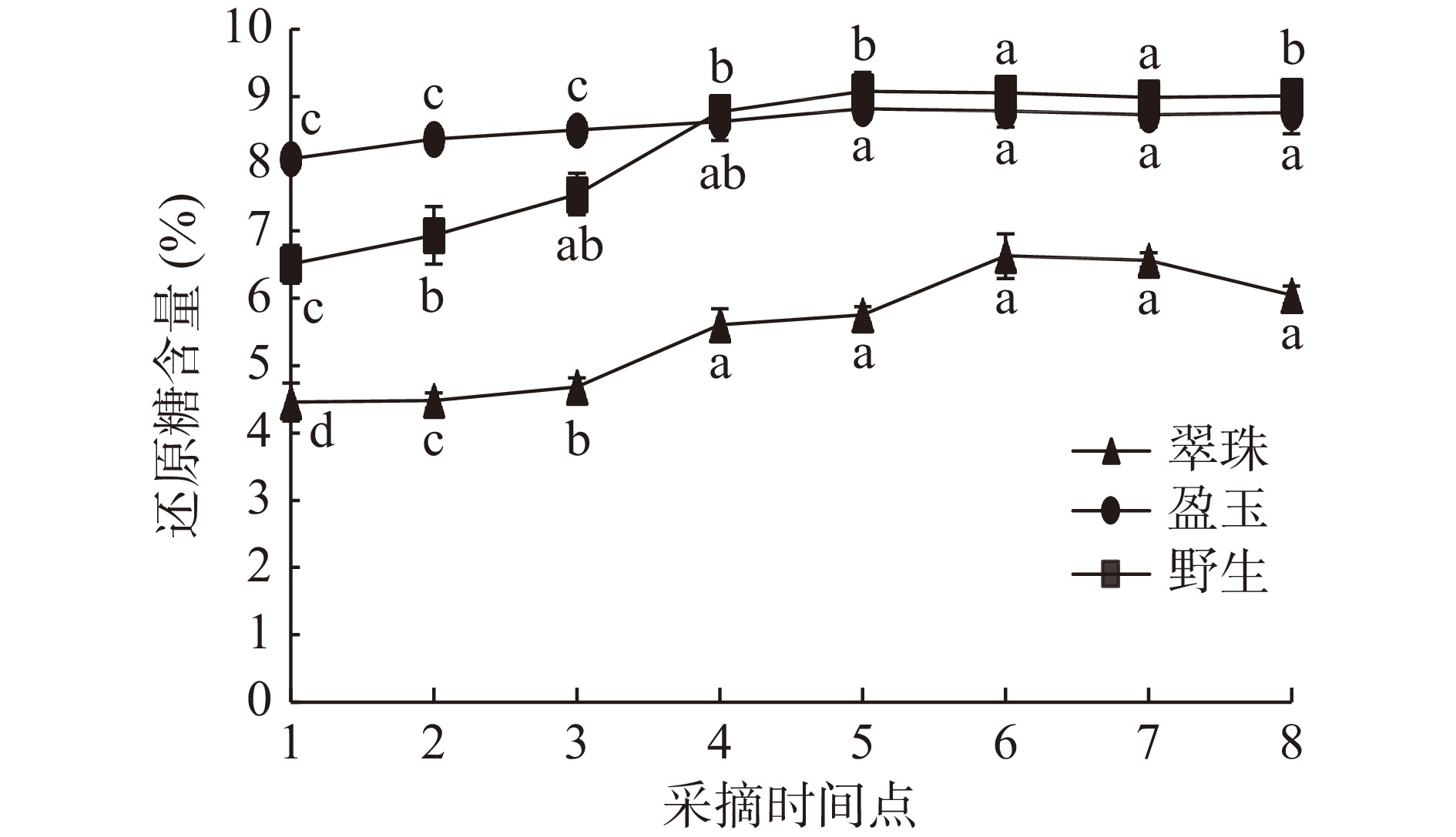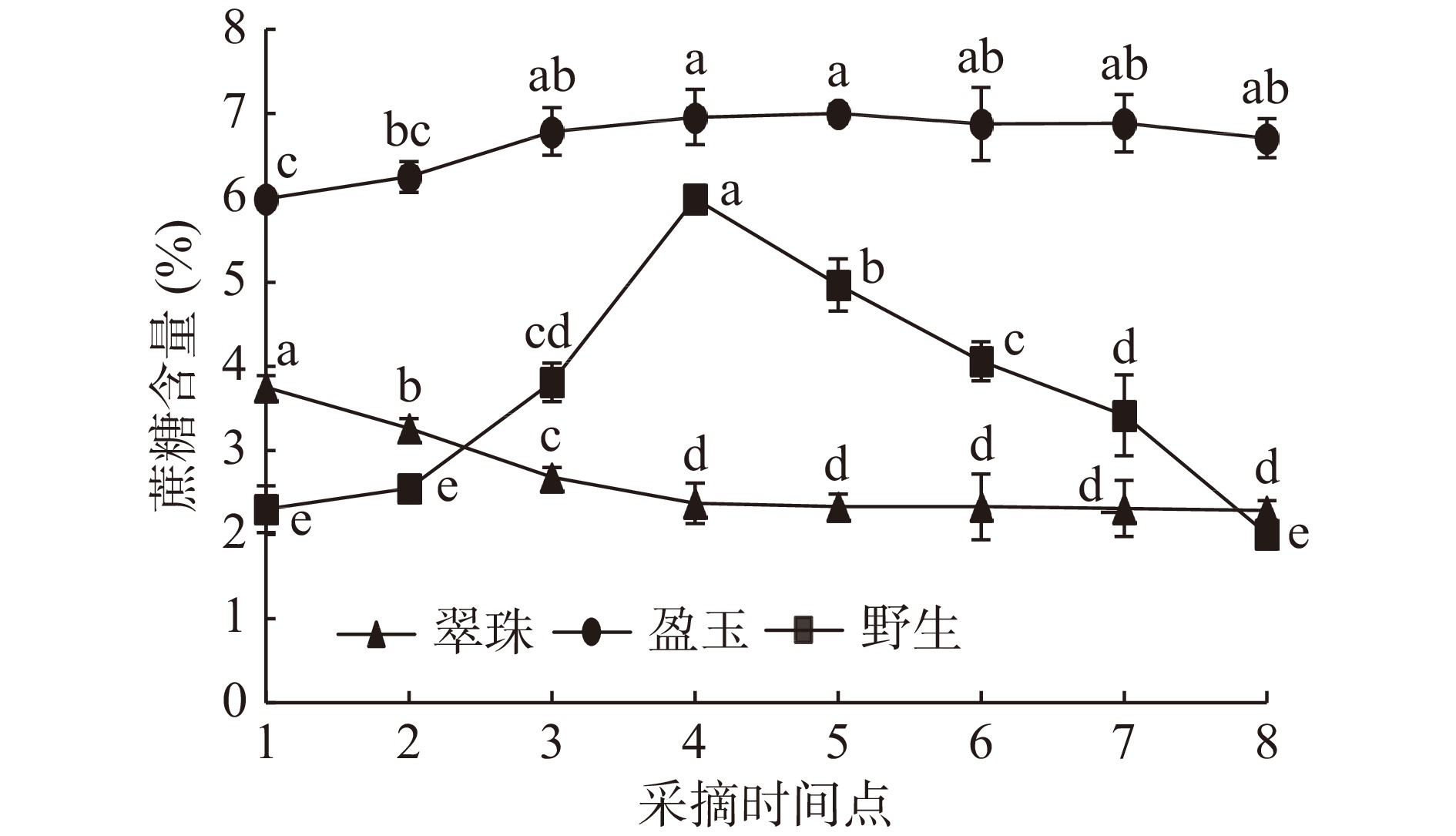Dynamic Quality Changes of Phyllanthus emblica L. in Different Picking Periods
-
摘要: 分析3个品种滇橄榄(‘翠珠’、‘盈玉’、野生)在不同采摘期的果实品质(物理指标及还原糖、蔗糖、总酸、VC、多酚、黄酮)变化规律,以确定不同滇橄榄品种的最佳采摘期。分析各品质指标的变化趋势并利用相关分析和判别分析对滇橄榄果实品质指标进行综合评价,分析得出物理指标呈现先上升后趋于稳定的变化规律;化学成分中总酸含量总体呈下降趋势后趋于稳定,除野生滇橄榄的蔗糖含量呈现先上升后下降趋势、‘翠珠’蔗糖含量呈下降后趋于稳定趋势外,3个品种的还原糖含量在整个采摘期都呈上升并趋于稳定的变化规律;活性成分中VC和黄酮含量呈现先上升后下降、多酚呈现先上升后趋于稳定趋势的变化规律。最终确定‘翠珠’的最佳采摘期在10月末~11月末,‘盈玉’和野生滇橄榄最佳采摘期在10月末~12月末。此阶段的滇橄榄果实外观大小、化学成分和活性成分均处于较优水平;各指标间相关性分析表明,3个品种滇橄榄各指标间的相关性强弱顺序为:野生>‘盈玉’>‘翠珠’;建立的3个品种滇橄榄的贝叶斯判别函数经交叉判别验证,正判率为100 %,可以正确判别不同品种的滇橄榄。本文研究结果可为滇橄榄的采摘、增值加工以及商品分类提供理论依据。Abstract: The changes of fruit quality (physical indexes, reducing sugar, sucrose, total acid, VC, polyphenols and flavonoids) of three Phyllanthus emblica L. varieties ('Cuizhu', 'Yingyu' and wild) at different picking stages were analyzed to determine the best picking date of different Phyllanthus emblica L. varieties. The change trend of each quality index was analyzed, and the fruit quality index of Phyllanthus emblica L. was comprehensively evaluated by correlation analysis and discriminant analysis. The analysis showed that the physical index increased first and then tended to be stable. The total acid content in the chemical components generally showed a downward trend and then tended to be stable. Except that the sucrose content of wild Phyllanthus emblica L. increased first and then decreased, and the sucrose content of 'Cuizhu' decreased and then tended to be stable, the reducing sugar content of the three varieties increased and tended to be stable throughout the picking period. The contents of VC and flavonoids in active components increased first and then decreased, and polyphenols increased first and then tended to be stable. Finally, it was determined that the best picking period of 'Cuizhu' was from the end of October to the end of November, and the best picking period of 'Yingyu' and wild was from the end of October to the end of December. The appearance, size, chemical components and active components of Phyllanthus emblica L. fruit at this stage were excellent. The correlation analysis among the indexes showed that the order of correlation among the indexes of the three varieties of Phyllanthus emblica L. was wild>'Yingyu'>'Cuizhu'. The Bayesian discriminant function of three varieties of Phyllanthus emblica L. was verified by cross discrimination, and the positive judgment rate was 100%, which could correctly distinguish different varieties of Phyllanthus emblica L. The results of this study would provide a theoretical basis for Phyllanthus emblica L. picking, value-added processing and commodity classification.
-
Keywords:
- Phyllanthus emblica L. /
- picking time /
- fruit quality /
- correlation analysis /
- discriminant analysis
-
滇橄榄(Phyllanthus embica L.)又名余甘子,为大戟科叶下珠属植物,云南省分布广泛。现代药理学研究表明,余甘子有免疫调节[1]、抗肿瘤[2]、抗炎[3-4]、抑菌[5]、抗氧化[6]、护肝[7]、降血压[8]、降血糖[9]、降尿酸[10]、抗细胞凋亡[11]等功效,在药用、保健食品方面有较高的开发价值。
由于橄榄种植地区的气候条件和种植品种不同,其采摘期具有不确定性,采摘过早,果实内部营养成分累积不足,不能充分展现果实原有的风味和营养价值。采摘过晚,错过营养成分富集高峰期,不能发挥应有的药理活性,且影响橄榄的贮存时间[12]。适期采摘是保证果实优质的前提。目前,对于‘翠珠’、‘盈玉’、野生3个品种的滇橄榄的采摘多依据经验,尚无最佳采摘期相关的研究。
如何适期采摘及保持滇橄榄果实品质是生产销售中亟待解决的问题。本研究以云南省宾川县滇橄榄种植基地的3个滇橄榄品种为实验对象,分析不同采摘期的滇橄榄品质指标,通过数据分析,揭示不同采摘期滇橄榄各品质指标的变化规律及各指标之间的相关性,确定最佳采摘期。
1. 材料与方法
1.1 材料与仪器
‘翠珠’滇橄榄、‘盈玉’滇橄榄、野生滇橄榄 均采摘于云南省宾川县有机滇橄榄种植基地,选择管理和长势一致且果树生长良好无病虫害的3个品种植株(树龄6年),每株分东南西北4个方向分别采集,每个方向采摘30颗果实。采摘时间从2020年9月中旬持续至2020年12月末(见表1),每两周采摘1次,共采摘8次。采摘后用保鲜盒分装并放于4 ℃保温箱中,当天运回大理大学食品质量与安全教研室。剔除伤果,选择大小、色泽均匀的新鲜果实,洗净晾干后4 ℃冷藏,待测;葡萄糖标准品(纯度≥98%)、L(+)-抗坏血酸标准品(纯度≥99.0%)、芦丁标准品(纯度≥98%)、没食子酸标准品(纯度≥98%)、乙酸锌(纯度≥99.0%) 均购于北京索莱宝科技有限公司;其他试剂 均为分析纯,购于天津市北辰方正试剂厂;实验室用水 为超纯水。
表 1 滇橄榄采摘时间(2020年)Table 1. Picking time of Phyllanthus emblica L. (year 2020)采摘时间
(月/日)9月15日 9月30日 10月15日 10月30日 11月15日 11月30日 12月15日 12月30日 采摘时间点 1 2 3 4 5 6 7 8 MNT-150T电子显数卡尺 上海美耐特实业有限公司;KQ-700DE数控超声波清洗器 昆山市超声仪器有限公司;TU-1810DPC紫外可见分光光度计 北京普析通用仪器有限责任公司;FW-80高速万能粉碎机 北京市永光明医疗仪器有限公司;GY-4数显果实硬度计 浙江托普云农科技股份有限公司。
1.2 实验方法
1.2.1 果实物理指标的测定
果实质量和大小测定:每个品种随机挑选果实30颗,电子天平称重法测定单果质量,电子显数卡尺测量单果最大横截面直径;果实硬度的测定参考NY/T 2009-2011进行测定;可食率的测定参考NY/T 750-2020进行测定。以上指标平均测量3次,计算平均值。
1.2.2 果实化学成分的测定
还原糖测定依据GB 5009.7-2016方法;蔗糖测定依据GB 5009.8-2016方法;抗坏血酸测定依据GB 5009.86-2016方法;总酸测定依据GB/T 12456-2008方法。
1.2.3 果实活性成分的测定
样液的制备:滇橄榄去核,经60 ℃恒温干燥4 h后,粉碎过80目筛得滇橄榄粉末。称取滇橄榄粉末5 g加入80 mL 70%乙醇,经温度60 ℃,功率210 W超声波辅助提取40 min后过滤,取滤液备用。
黄酮的测定:参考文献[13],采用NaNO2-Al(NO3)3显色法绘制芦丁标准曲线为Y=0.9777x+0.0058(R2=0.9993);多酚的测定:参考文献[14],采用福林酚显色法绘制没食子酸标准曲线为Y=1.1783x+0.0093(R2=0.9991)。
1.3 数据处理
数据结果以平均值±标准差表示,采用Microsoft Excel 13.0制图,SPSS 25.0进行判别分析、相关分析及显著性检验(P<0.05)。
2. 结果与分析
2.1 物理指标分析
通过分析橄榄果实直径、单果重、硬度以及果实中总酸、还原糖、蔗糖含量的变化趋势可以了解果实生长发育状况,掌握其生长发育规律和节点,为制定适宜的采摘期提供依据[15-16]。
由表2可知,3个品种滇橄榄果实物理指标的变化趋势一致,均表现为先增加后保持稳定的趋势。‘翠珠’滇橄榄果实各项物理指标在第1个采摘点(2020-9-15)时最低,第5个采摘点(2020-11-15)后各项指标达到最高且保持稳定:直径24.20~24.29 mm、单果重7.20~7.29 g、可食率87.29%~87.43 %、硬度3.98~4.03 g。‘盈玉’滇橄榄果实的物理指标变化趋势与‘翠珠’滇橄榄一致,第5个采摘点(2020-11-15)后各项指标保持在直径37.94~37.82 mm、单果重29.94~30.15 g、可食率90.05%~90.71 %、硬度6.03~6.14 g。野生滇橄榄果实第6个采摘点(2020-11-30)各物理指标达峰值,后各项指标保持在16.86~17.42 mm、3.22~3.73 g、79.83%~79.89%、4.87~5.07 g。‘翠珠’和‘盈玉’滇橄榄的物理指标在第5个采摘点(2020-11-15)达高峰后趋于稳定,野生滇橄榄的物理指标在第6个采摘点(2020-11-30)达高峰后趋于稳定。
表 2 采摘时间对不同品种滇橄榄物理指标的影响Table 2. Effect of picking time on physical indexes of Phyllanthus emblica L.品种 采摘时间点 直径(mm) 单果重(g) 可食率(%) 硬度(g) 翠珠滇橄榄 1 22.36±0.15d 4.76±0.21c 76.39±0.11c 3.66±0.07c 2 22.43±0.06d 5.63±0.17bc 83.34±0.12b 3.83±0.17bc 3 23.56±0.14c 6.25±0.06abc 83.92±0.07b 3.90±0.11b 4 23.69±0.04bc 6.69±0.07ab 87.76±0.12a 3.95±0.28ab 5 24.51±0.05a 7.68±0.12ab 87.73±0.03a 4.19±0.07a 6 24.29±0.03ab 7.20±0.10ab 87.29±0.13a 4.02±0.06ab 7 24.22±0.12ab 7.04±0.04ab 87.31±0.06a 3.98±0.03ab 8 24.20±0.07ab 7.29±0.03a 87.43±0.03a 4.03±0.03ab 盈玉滇橄榄 1 30.24±0.17e 19.71±0.14e 88.77±0.06c 4.26±0.12c 2 32.34±0.21d 20.65±0.08d 89.92±0.13ab 4.46±0.06c 3 35.77±0.09c 25.10±0.03c 89.81±0.12b 4.62±0.03c 4 36.74±0.12b 29.56±0.12b 90.17±0.12ab 5.26±0.03b 5 38.17±0.31a 30.46±0.10a 91.03±0.12a 6.16±0.11a 6 37.82±0.11a 30.15±0.13ab 90.71±0.14ab 6.14±0.12a 7 37.87±0.03a 29.96±0.09ab 90.06±0.06ab 6.02±0.10a 8 37.94±0.28a 29.94±0.28ab 90.05±0.17ab 6.03±0.12a 野生滇橄榄 1 14.62±0.14d 2.75±0.14c 74.91±0.12c 3.49±0.10d 2 15.61±0.03c 2.90±0.03bc 75.71±0.11c 3.89±0.28c 3 16.52±0.10b 3.00±0.11bc 77.95±0.13b 4.51±0.10b 4 16.62±0.12b 3.45±0.03bc 79.24±0.07a 4.91±0.03ab 5 16.76±0.15ab 3.68±0.31a 80.08±0.18a 5.03±0.14a 6 17.42±0.28a 3.73±0.03a 79.83±0.09a 5.07±0.10ab 7 17.12±0.11ab 3.33±0.12abc 79.89±0.10a 4.88±0.28ab 8 16.86±0.03ab 3.22±0.09abc 79.85±0.09a 4.87±0.09ab 注:同一品种同列不同小写字母表示0.05水平差异显著。 外观品质和加工品质是衡量果实品质的重要指标。通过对3个品种滇橄榄果实物理指标的对比发现,以第5个采摘点为例,‘盈玉’滇橄榄的单果直径、单果重、可食率和硬度均高于‘翠珠’和野生两个品种,且‘盈玉’果实鲜亮通透,外皮光滑,从产品加工角度出发,在鲜食、果脯加工和榨取滇橄榄果汁等方面,‘盈玉’滇橄榄较‘翠珠’和野生滇橄榄均具备更好的外观优势、加工品质及产品产量优势[17]。
2.2 化学成分分析
2.2.1 不同采摘时间滇橄榄总酸含量的变化
不同成熟期滇橄榄果实的总糖随着成熟度的增加而增加,总酸随着成熟度的增加而降低[18]。由图1可知,‘翠珠’和‘盈玉’滇橄榄总酸含量总体呈下降趋势后趋于稳定。野生滇橄榄含量在采摘点5(2020-11-15)达到高峰,后呈平稳下降趋势。果实总酸含量变化是一个极为复杂的过程,涉及到多种不同的酶,不同品种总酸含量存在差异可能与不同品种的内在遗传特性、外在自然环境的适应情况有关。一方面随着果实成熟度增加,果实体积迅速膨大从而降低总酸的含量;另一方面由于营养物质累积,果实内部营养成分发生果酸向糖的转化或果酸成为呼吸底物被消耗。这与赵琼玲等[19]研究结果相一致。
2.2.2 不同采摘时间滇橄榄中还原糖和蔗糖含量的变化
糖和酸的构成和含量水平是决定水果甜酸风味的关键因素[20],可溶性糖和有机酸是水果中的主要风味物质,且可溶性糖与水果甜度呈线性相关关系,是反映水果甜度的适宜指标,其中可溶性糖主要包含还原糖和蔗糖。
果实在发育成熟过程中口感和风味物质会发生变化[21]。由图2可知,‘盈玉’滇橄榄的还原糖含量在整个采摘期波动不大,一直处于较高水平。野生滇橄榄还原糖含量在采摘点4(2020-10-30)含量达到峰值,与‘盈玉’滇橄榄还原糖含量接近。‘翠珠’滇橄榄还原糖含量整体低于‘野生’和‘盈玉’滇橄榄。由图3可看出在采摘时间范围内‘盈玉’滇橄榄蔗糖含量明显高于‘翠珠’和野生滇橄榄,在采摘点3(2020-10-15)后至采摘结束均维持在较高水平。‘翠珠’滇橄榄采摘初期蔗糖含量水平较高,后逐渐呈下降趋势并在采摘期结束前趋于稳定在2.30 %左右。‘翠珠’和‘盈玉’滇橄榄的还原糖、蔗糖和总酸含量在采摘点4(2020-10-30)后均保持稳定。野生滇橄榄蔗糖含量先增加后下降,在采摘点4(2020-10-30)蔗糖含量达到峰值。从3个不同品种滇橄榄的还原糖含量、蔗糖含量变化趋势来看,除野生滇橄榄的蔗糖含量出现单峰,‘翠珠’滇橄榄的蔗糖含量自采摘开始至采摘点3(2020-10-15)呈下降趋势后趋于稳定外,3个品种的还原糖含量在整个采摘期都在增加,其原因可能是在果实发育过程中,还原糖的积累速度快于蔗糖;野生滇橄榄蔗糖含量出现单峰和‘翠珠’滇橄榄的蔗糖含量呈下降趋势可能与品种不同、内在酶[22]活性不同有关。
2.3 活性成分分析
在成熟过程中,橄榄果实品质、营养成分和活性物质的种类及含量变化显著[23],随着成熟度的增加,橄榄鲜果提取物的抗氧化能力逐渐增强[24],滇橄榄中具有抗氧化能力的活性成分包括VC、黄酮和多酚。
2.3.1 不同采摘时间滇橄榄中VC含量的变化
滇橄榄果实富含VC,VC稳定性高[25-26]且具有较高的抗氧化活性与生物利用度[27]。有研究表明,11月上旬采摘的“六月白”和“蓝田粉甘”橄榄果实VC含量最高,最高含量分别为3.70和4.76 mg/g,最高含量所在时期采摘的果实更适合做功能食品开发的原料[28]。由图4可知,3个品种滇橄榄VC含量总体呈先上升后下降趋势,野生滇橄榄与‘盈玉’滇橄榄VC含量较高,在采摘点5(2020-11-15)峰值分别达到552.01±1.28和553.66±2.12 mg/100 g,高于‘六月白’和‘蓝田粉甘’橄榄果实的VC含量。‘翠珠’滇橄榄VC含量相对最低。采摘点5(2020-11-15)到采摘点6(2020-11-30),野生和‘盈玉’滇橄榄的VC含量仍能维持在较高水平,在这一采摘阶段采摘可获得较高VC含量的滇橄榄。此结论与陈洪彬等[29]的滇橄榄VC含量在11月达最大值的结论相一致。
VC和抗坏血酸氧化酶与果实细胞膨大和分裂密切相关[30]。在采摘点5(2020-11-15)前VC呈上升趋势是因为橄榄果实在成熟过程中,可能由L-半乳糖途径VC不断积累导致[31]。随着果实细胞分裂、体积不断增大,抗坏血酸氧化酶增强,将VC氧化成单脱氢抗坏血酸,加上后期果实体积变化不大,还原糖、蔗糖不断积累,气温升高导致VC被分解使得VC含量在采摘点5后呈下降趋势[32]。
2.3.2 不同采摘时间滇橄榄中黄酮和多酚含量的变化
由图5所示,从采摘点1(2020-9-15)开始,‘盈玉’和‘翠珠’的黄酮含量不断积累,总体呈现先上升后下降的趋势,黄酮含量均在采摘点4(2020-10-30)达到高峰,分别为4205.70±4.73、3192.46±1.52 mg/100 g,之后呈下降趋势。野生滇橄榄的黄酮含量总体缓慢上升,在采摘点5(2020-11-15)达到峰值3738.25±2.58 mg/100 g,且一直保持该峰值直到采摘结束(2020-12-30)。‘翠珠’滇橄榄的黄酮含量始终低于‘盈玉’和野生滇橄榄。
由图6可知,整个采摘期野生和‘盈玉’滇橄榄的多酚含量均高于‘翠珠’滇橄榄。‘翠珠’和‘盈玉’滇橄榄的多酚含量均在在采摘点5(2020-11-15)达到峰值,分别为3738.25±2.58和3981.52±2.32 mg/100 g,而后‘盈玉’的多酚含量趋于稳定,‘翠珠’的多酚含量逐渐下降。野生滇橄榄的多酚含量在采摘点4(2020-10-30)达到峰值4166.96±1.32 mg/100 g且一直保持在较高水平,直至采摘结束(2020-12-30)。
黄酮含量高低与抗氧化活性密切相关[33-34]。结合图5所示黄酮含量,在10月末至12月中旬黄酮含量最高的阶段采摘‘盈玉’和‘野生’滇橄榄,显著高于葡萄、芒果、草莓乙醇提取物的黄酮含量[35],且有研究表明滇橄榄果实中富含多酚和黄酮类活性物质,对DPPH·、ABTS+·、羟自由基具有极强的抗氧化能力[36],对DPPH自由基、羟自由基的清除能力高于茶多酚[37-38]。由此可说明滇橄榄黄酮可作为较好的抗氧化剂来源。
从物理指标、化学成分和活性成分的角度,综合各指标的变化规律,‘翠珠’、‘盈玉’、野生滇橄榄最佳采摘期分别确定在10月末~11月末、10月末~12月末、10月末~12月末。
2.4 不同品种滇橄榄各品质指标间相关性分析
对10个品质指标进行Spearman相关性分析,由表3~表5可知,滇橄榄果实中各指标间存在密切关系,但是不同指标对不同品种滇橄榄的影响不同,且同一指标在不同品种滇橄榄中的相关性大小也不同。
表 3 ‘翠珠’滇橄榄品质指标相关性分析Table 3. Correlation analysis of quality indexes of ‘Cuizhu’ Phyllanthus emblica L.相关系数 还原糖 蔗糖 VC 总酸 黄酮 多酚 直径 单果重 可食率 硬度 还原糖 1 蔗糖 −0.874** 1 VC −0.429 0.467 1 总酸 −0.905** 0.994** 0.524 1 黄酮 0.238 −0.120 0.714* −0.095 1 多酚 0.810* −0.683 0.143 −0.667 0.619 1 直径 0.857** −0.778* 0 −0.762* 0.476 0.976** 1 单果重 0.786* −0.862** −0.071 −0.833* 0.357 0.857** 0.929** 1 可食率 0.524 −0.659 0.238 −0.619 0.667 0.714* 0.667 0.738* 1 硬度 0.786* −0.862** −0.071 −0.833* 0.357 0.857** 0.929** 1.000** 0.738* 1 注:**表示在0.01级别(双尾),相关性极显著;*表示在0.05级别(双尾),相关性显著;表4~表5同。 表 4 ‘盈玉’滇橄榄品质指标相关性分析Table 4. Correlation analysis of quality indexes of ‘Yingyu’ Phyllanthus emblica L.相关系数 还原糖 蔗糖 VC 总酸 黄酮 多酚 直径 单果重 可食率 硬度 还原糖 1 蔗糖 0.714* 1 VC 0.929** 0.881** 1 总酸 −0.786* −0.452 −0.667 1 黄酮 0.524 0.881** 0.667 −0.238 1 多酚 0.833* 0.833* 0.810* −0.619 0.762* 1 直径 0.905** 0.619 0.786* −0.833* 0.405 0.738* 1 单果重 0.976** 0.786* 0.976** −0.762* 0.548 0.786* 0.881** 1 可食率 0.881** 0.857** 0.952** −0.571 0.667 0.857** 0.667 0.905** 1 硬度 1.000** 0.714* 0.929** −0.786* 0.524 0.833* 0.905** 0.976** 0.881** 1 表 5 野生滇橄榄品质指标相关性分析Table 5. Correlation analysis of quality indexes of wild Phyllanthus emblica L.相关系数 还原糖 蔗糖 VC 总酸 黄酮 多酚 直径 单果重 可食率 硬度 还原糖 1 蔗糖 0.405 1 VC 0.976** 0.476 1 总酸 0.833* 0.833* 0.881** 1 黄酮 0.976** 0.286 0.929** 0.738* 1 多酚 0.952** 0.381 0.881** 0.762* 0.976** 1 直径 0.833* 0.238 0.857** 0.667 0.786* 0.714* 1 单果重 0.881** 0.714* 0.905** 0.952** 0.786* 0.810* 0.810* 1 可食率 0.905** 0.310 0.929** 0.738* 0.929** 0.857** 0.786* 0.738* 1 硬度 0.881** 0.714* 0.905** 0.952** 0.786* 0.810* 0.810* 1.000** 0.738* 1 各指标间相关性最强的是野生滇橄榄,其VC、黄酮、多酚3个指标间呈极显著正相关关系(P<0.01),‘盈玉’滇橄榄次之,‘翠珠’滇橄榄最差。‘盈玉’滇橄榄蔗糖、还原糖与总酸呈极显著负相关关系(P<0.01),表明蔗糖、还原糖含量越高,总酸含量越低。其中,‘盈玉’和野生滇橄榄的VC、黄酮、多酚与直径、单果重、可食率均呈显著或极显著相关(P<0.05或P<0.01),说明直径、单果重、可食率越大,越能显著或极显著提高VC、黄酮、多酚这3项的水平,由此可见,在采摘时间范围内越晚采摘的滇橄榄果实的活性成分价值更高。
2.5 不同品种滇橄榄分类的判别分析
应用判别分析的目的在于建立一种变量的线性组合来概括分类之间的差异,从而可以根据已知样本的分类情况来判断未知分类样本的归属问题[39]。通过对上述10个指标为变量进行判别分析,以期建立区分不同滇橄榄品种的判别函数。
2.5.1 典型判别分析
以Wilks’ Lambda检验(P<0.05有统计学差异)对各特征值进一步检验,得到典型判别函数:
D1=−105.241+2.934×还原糖含量−0.386×蔗糖含量+0.013×VC含量+1.783×总酸含量−0.006×黄酮含量−0.009×多酚含量+1.164×直径+2.203×重量+1.236×可食率−9.258×硬度
D2=33.443+2.516×还原糖含量−0.258×蔗糖含量+0.001×VC含量+0.422×总酸含量−0.910×直径+0.949×重量-0.407×可食率−1.788×硬度
将所得采收数据代入函数式,得出相应滇橄榄的函数范围。如图7所示,‘翠珠’滇橄榄的横坐标范围在−9.29~−13.62,纵坐标范围在−6.12~−8.96;‘盈玉’滇橄榄的横坐标范围在40.44~43.00,纵坐标范围在1.68~5.61;野生滇橄榄的横坐标范围在−33.60~−37.96,纵坐标范围在3.51~6.51。两个维度由第一个典型判别函数和第二个典型判别函数构成,显然3种滇橄榄的空间位置距离较远,不容易错判。从该图中同样可以看到第一和第二个维度上3种不同类型的滇橄榄得以区分。
2.5.2 贝叶斯判别分析
贝叶斯理论基础相比于典型判别分析更具有统计理论支持,它能计算每个样本的后验概率以及错判率,用最大后验概率来对样本进行分类,并使得期望损失降到最小[40]。因此,对3个品种滇橄榄进行贝叶斯判别分析,得到费希尔线性判别函数式:
‘翠珠’滇橄榄:Y=−7515.887+66.130×还原糖含量−76.661×蔗糖含量+0.166×VC含量+294.929×总酸含量−0.817×黄酮含量−0.353×多酚含量+123.464×直径+196.874×单果重+180.609×可食率−747.270×硬度
‘盈玉’滇橄榄:Y=−13609.169+250.877×还原糖含量−100.213×蔗糖含量+0.897×VC含量+395.507×总酸含量−1.133×黄酮含量−0.851×多酚含量+176.609×直径+325.672×单果重+242.918×可食率−1265.212×硬度
野生滇橄榄:Y=−5089.202+28.791×还原糖含量−70.767×蔗糖含量−0.143×VC含量+257.585×总酸含量−0.681×黄酮含量−0.132×多酚含量+83.396×直径+156.387×单果重+145.474×可食率−548.061×硬度
可将检测所得数值按对应指标代入上述3个判别函数式,计算得到3种滇橄榄的得分,哪个函数的计算值最大,即可判别为相应所属的滇橄榄品种。函数在Wilks’ Lambda检验中P值均小于0.05,具有统计学意义。采用交叉验证法验证判别结果,其正判率为100%,说明所建判别函数对滇橄榄分类具有很好的判别效果。在本实验中品质指标如还原糖、蔗糖、VC、总酸、黄酮、多酚和物理指标如直径、单果重、可食率、硬度为变量建立判别函数能正确区分‘翠珠’滇橄榄、‘盈玉’滇橄榄和野生滇橄榄。
3. 结论
在滇橄榄食品或药用加工中,可以根据不同的加工目的选择适宜的采摘时间[41-43]。从物理指标、化学成分及活性成分角度,‘翠珠’、‘盈玉’、野生滇橄榄采摘期分别确定在10月末~11月末、10月末~12月末、10月末~12月末。同时建立的3个不同品种的两种滇橄榄判别函数式经交叉判别验证,正判率为100%,可以正确判别不同品种的滇橄榄。对滇橄榄果实品质指标情况的充分掌握,是滇橄榄资源得到科学有效利用的保障。因此,对滇橄榄品质特征及分类的相关研究确有必要,可为滇橄榄的合理利用与产业发展提供一定的理论依据。云南省滇橄榄资源丰富,在后续研究中可继续扩大不同品种滇橄榄的采集,完善滇橄榄品质评价体系的建设,以达到合理利用滇橄榄资源的目的。
-
表 1 滇橄榄采摘时间(2020年)
Table 1 Picking time of Phyllanthus emblica L. (year 2020)
采摘时间
(月/日)9月15日 9月30日 10月15日 10月30日 11月15日 11月30日 12月15日 12月30日 采摘时间点 1 2 3 4 5 6 7 8 表 2 采摘时间对不同品种滇橄榄物理指标的影响
Table 2 Effect of picking time on physical indexes of Phyllanthus emblica L.
品种 采摘时间点 直径(mm) 单果重(g) 可食率(%) 硬度(g) 翠珠滇橄榄 1 22.36±0.15d 4.76±0.21c 76.39±0.11c 3.66±0.07c 2 22.43±0.06d 5.63±0.17bc 83.34±0.12b 3.83±0.17bc 3 23.56±0.14c 6.25±0.06abc 83.92±0.07b 3.90±0.11b 4 23.69±0.04bc 6.69±0.07ab 87.76±0.12a 3.95±0.28ab 5 24.51±0.05a 7.68±0.12ab 87.73±0.03a 4.19±0.07a 6 24.29±0.03ab 7.20±0.10ab 87.29±0.13a 4.02±0.06ab 7 24.22±0.12ab 7.04±0.04ab 87.31±0.06a 3.98±0.03ab 8 24.20±0.07ab 7.29±0.03a 87.43±0.03a 4.03±0.03ab 盈玉滇橄榄 1 30.24±0.17e 19.71±0.14e 88.77±0.06c 4.26±0.12c 2 32.34±0.21d 20.65±0.08d 89.92±0.13ab 4.46±0.06c 3 35.77±0.09c 25.10±0.03c 89.81±0.12b 4.62±0.03c 4 36.74±0.12b 29.56±0.12b 90.17±0.12ab 5.26±0.03b 5 38.17±0.31a 30.46±0.10a 91.03±0.12a 6.16±0.11a 6 37.82±0.11a 30.15±0.13ab 90.71±0.14ab 6.14±0.12a 7 37.87±0.03a 29.96±0.09ab 90.06±0.06ab 6.02±0.10a 8 37.94±0.28a 29.94±0.28ab 90.05±0.17ab 6.03±0.12a 野生滇橄榄 1 14.62±0.14d 2.75±0.14c 74.91±0.12c 3.49±0.10d 2 15.61±0.03c 2.90±0.03bc 75.71±0.11c 3.89±0.28c 3 16.52±0.10b 3.00±0.11bc 77.95±0.13b 4.51±0.10b 4 16.62±0.12b 3.45±0.03bc 79.24±0.07a 4.91±0.03ab 5 16.76±0.15ab 3.68±0.31a 80.08±0.18a 5.03±0.14a 6 17.42±0.28a 3.73±0.03a 79.83±0.09a 5.07±0.10ab 7 17.12±0.11ab 3.33±0.12abc 79.89±0.10a 4.88±0.28ab 8 16.86±0.03ab 3.22±0.09abc 79.85±0.09a 4.87±0.09ab 注:同一品种同列不同小写字母表示0.05水平差异显著。 表 3 ‘翠珠’滇橄榄品质指标相关性分析
Table 3 Correlation analysis of quality indexes of ‘Cuizhu’ Phyllanthus emblica L.
相关系数 还原糖 蔗糖 VC 总酸 黄酮 多酚 直径 单果重 可食率 硬度 还原糖 1 蔗糖 −0.874** 1 VC −0.429 0.467 1 总酸 −0.905** 0.994** 0.524 1 黄酮 0.238 −0.120 0.714* −0.095 1 多酚 0.810* −0.683 0.143 −0.667 0.619 1 直径 0.857** −0.778* 0 −0.762* 0.476 0.976** 1 单果重 0.786* −0.862** −0.071 −0.833* 0.357 0.857** 0.929** 1 可食率 0.524 −0.659 0.238 −0.619 0.667 0.714* 0.667 0.738* 1 硬度 0.786* −0.862** −0.071 −0.833* 0.357 0.857** 0.929** 1.000** 0.738* 1 注:**表示在0.01级别(双尾),相关性极显著;*表示在0.05级别(双尾),相关性显著;表4~表5同。 表 4 ‘盈玉’滇橄榄品质指标相关性分析
Table 4 Correlation analysis of quality indexes of ‘Yingyu’ Phyllanthus emblica L.
相关系数 还原糖 蔗糖 VC 总酸 黄酮 多酚 直径 单果重 可食率 硬度 还原糖 1 蔗糖 0.714* 1 VC 0.929** 0.881** 1 总酸 −0.786* −0.452 −0.667 1 黄酮 0.524 0.881** 0.667 −0.238 1 多酚 0.833* 0.833* 0.810* −0.619 0.762* 1 直径 0.905** 0.619 0.786* −0.833* 0.405 0.738* 1 单果重 0.976** 0.786* 0.976** −0.762* 0.548 0.786* 0.881** 1 可食率 0.881** 0.857** 0.952** −0.571 0.667 0.857** 0.667 0.905** 1 硬度 1.000** 0.714* 0.929** −0.786* 0.524 0.833* 0.905** 0.976** 0.881** 1 表 5 野生滇橄榄品质指标相关性分析
Table 5 Correlation analysis of quality indexes of wild Phyllanthus emblica L.
相关系数 还原糖 蔗糖 VC 总酸 黄酮 多酚 直径 单果重 可食率 硬度 还原糖 1 蔗糖 0.405 1 VC 0.976** 0.476 1 总酸 0.833* 0.833* 0.881** 1 黄酮 0.976** 0.286 0.929** 0.738* 1 多酚 0.952** 0.381 0.881** 0.762* 0.976** 1 直径 0.833* 0.238 0.857** 0.667 0.786* 0.714* 1 单果重 0.881** 0.714* 0.905** 0.952** 0.786* 0.810* 0.810* 1 可食率 0.905** 0.310 0.929** 0.738* 0.929** 0.857** 0.786* 0.738* 1 硬度 0.881** 0.714* 0.905** 0.952** 0.786* 0.810* 0.810* 1.000** 0.738* 1 -
[1] 骆扬, 晏琴丽. 海藻酸钠茶多酚复配涂膜对滇橄榄贮藏品质的影响[J]. 保鲜与加工,2019,19(2):29−35. [LUO Y, YAN Q L. Effect of sodium alginate and tea polyphenols compound coating on storage quality of Phyllanthus emblica[J]. Storage and Process,2019,19(2):29−35. doi: 10.3969/j.issn.1009-6221.2019.02.005 [2] 张光云, 陈普. 藏药抗肿瘤的研究概况[J]. 中国民族民间医药,2019,28(13):72−75. [ZHANG G Y, CHEN P. Research overview of Tibetan medicine anti-tumor[J]. Chinese National and Folk Medicine,2019,28(13):72−75. [3] 朱华伟, 李伟, 陈运娇, 等. 余甘子化学成分及其抗炎作用的研究进展[J]. 中成药,2018,40(3):670−674. [ZHU H W, LI W, CHEN Y J, et al. Research progress on chemical constituents and anti-inflammatory effects of Phyllanthus emblica[J]. Chinese Patent Medicine,2018,40(3):670−674. doi: 10.3969/j.issn.1001-1528.2018.03.033 [4] WANG H M, FU L, CHENG C C, et al. Inhibition of LPS-induced oxidative damages and potential anti-inflammatory effects of Phyllanthus emblica extract via down-regulating NF-κB, COX-2, and iNOS in RAW 264.7 cells[J]. Antioxidants,2019,8(8):138−145.
[5] 罗传红, 黄胜杰, 胡琪琪, 等. 去核对余甘子药材质量的影响[J]. 中国实验方剂学杂志,2021,27(9):147−156. [LUO C H, HUANG S J, HU Q Q, et al. To check the influence of Phyllanthus emblica on the quality of medicinal materials[J]. Chinese Journal of Experimental Formulary,2021,27(9):147−156. [6] 李伟, 张小英, 叶嘉宜, 等. 余甘子不同溶剂提取物体外抗氧化活性及对H2O2诱导RAW264.7细胞损伤的保护作用[J]. 食品与发酵工业,2020,46(16):62−69. [LI W, ZHANG X Y, YE J Y, et al. In vitro antioxidant activity of different solvent extracts of Phyllanthus emblica and their protective effect on H2O2 induced RAW264.7 cell damage[J]. Food and Fermentation Industry,2020,46(16):62−69. [7] LU C, YANG S, HSIA S, et al. Inhibitory effects of Phyllanthus emblica on hepatic steatosis and liver fibrosis in vitro[J]. J Funct Foods,2016,20:20−30. doi: 10.1016/j.jff.2015.10.012
[8] AHMED A. The effect of water extracts of Phyllanthus emblica and costusspeciousus on reducing obesity in albino rats[J]. Al- exandria Sci Exchange J,2017,38(3):464−473.
[9] MUSRI M, MAULI Z, RATU F R, et al. Pharmaceutical hit of anti type 2 diabetes mellitus on the phenolic extract of malaka (Phyllanthus emblica L.) flesh[J]. Clinical Phytoscience: International Journal of Phytomedicine and Phytotherapy,2019,5(2):155−171.
[10] SARVAIYA V N, SADARIYA K A, PANCHA P G, et al. Evaluation of antigout activity of Phyllanthus emblica fruit extracts on potassiumoxonate-induced gout rat model[J]. Veterinary World,2015,8(10):1230−1236. doi: 10.14202/vetworld.2015.1230-1236
[11] KUNCHANA K, JARISARAPURIN W, CHULAROJMONTRI L, et al. Potential use of amla (Phyllanthus emblica L.) fruit extract to protect skin keratinocytes from inflammation and apoptosis after uvbirradiation[J]. Antioxidants (Basel, Switzerland),2021,10(5):703.
[12] 孔祥佳, 任思琪, 林河通, 等. 不同成熟度橄榄果实冷藏期间细胞壁代谢对采后冷害的响应特性[J]. 食品科学,2018,39(3):229−235. [KONG X J, REN S Q, LIN H T, et al. Response characteristics of cell wall metabolism to postharvest chilling injury of olive fruits with different maturity during cold storage[J]. Food Science,2018,39(3):229−235. doi: 10.7506/spkx1002-6630-201803035 [13] 陈洪彬, 郑金水, 蔡英卿, 等. 紫苏叶中总黄酮的超声波辅助提取工艺优化[J]. 食品与机械,2014,30(5):232−236. [CHEN H B, ZHENG J S, CAI Y Q, et al. Optimization of ultrasonic assisted extraction process of total flavonoids from perilla leaves[J]. Food and Machinery,2014,30(5):232−236. [14] 李永强, 杨士花, 付晓萍, 等. 多酚对杨梅花色苷的辅色作用及稳定性的影响[J]. 食品与发酵工业,2011,37(4):64−67. [LI Y Q, YANG S H, FU X P, et al. Effects of polyphenols on the co color effect and stability of Myrica rubra anthocyanins[J]. Food and Fermentation Industry,2011,37(4):64−67. [15] 杨从华, 宁德鲁, 石卓功, 等. 油橄榄在云南的果实生长发育特性分析[J]. 经济林研究,2020,38(1):177−183. [YANG C H, NING D L, SHI Z G, et al. Analysis on fruit growth and development characteristics of olive in Yunnan[J]. Study on Economic Forest,2020,38(1):177−183. [16] 闫辉强, 后春静, 马君义, 等. 不同品种和成熟度的油橄榄果表型性状与脂肪酸组成及含量分析[J]. 中国油脂,2019,44(4):105−111. [YAN H Q, HOU C J, MA J Y, et al. Analysis of phenotypic characters, fatty acid composition and content of olive fruit with different varieties and maturity[J]. China Oil,2019,44(4):105−111. doi: 10.3969/j.issn.1003-7969.2019.04.024 [17] 张雯雯, 李坤, 徐涓, 等. 新品种余甘子盈玉和糯种的果实性状及果实品质的差异性分析[J]. 食品科学,2019,40(2):180−185. [ZHANG W W, LI K, XU J, et al. Analysis on the difference of fruit characters and fruit quality between Yuganzi yingyu and waxy varieties[J]. Food Science,2019,40(2):180−185. doi: 10.7506/spkx1002-6630-20180614-262 [18] 赵琼玲, 金杰, 罗会英, 等. 不同颜色余甘子果实发育过程中5种生理指标的变化及其相关性[J]. 热带农业科学,2018,38(3):20−24. [ZHAO Q L, JIN J, LUO H Y, et al. Changes and correlation of five physiological indexes during fruit development of Phyllanthus emblica with different colors[J]. Tropical Agricultural Science,2018,38(3):20−24. [19] 赵琼玲, 张永辉, 罗会英, 等. 霜冻前后野生余甘子果实功能成分的变化[J]. 经济林研究,2020,38(2):9−16. [ZHAO Q L, ZHANG Y H, LUO H Y, et al. Changes of functional components of wild Phyllanthus emblica fruit before and after frost[J]. Study on Economic Forest,2020,38(2):9−16. [20] 郑丽静, 聂继云, 闫震, 等. 糖酸组分及其对水果风味的影响研究进展[J]. 果树学报,2015,32(2):304−312. [ZHENG L J, NIE J Y, YAN Z, et al. Research progress on sugar and acid components and their effects on fruit flavor[J]. Journal of Fruit Trees,2015,32(2):304−312. [21] 邱志浩, 陈晶英, 彭远琴, 等. 橄榄果实发育过程中细胞壁物质和相关酶活性变化[J]. 热带亚热带植物学报,2019,27(6):677−683. [QIU Z H, CHEN J Y, PENG Y Q, et al. Changes of cell wall substances and related enzyme activities during olive fruit development[J]. Journal of Tropical and Subtropical Plants,2019,27(6):677−683. doi: 10.11926/jtsb.4028 [22] 赵淼. 柑橘果实有机酸代谢及调控研究[D]. 合肥: 安徽农业大学, 2008. ZHAO M. Study on organic acid metabolism and regulation of citrus fruit [D]. Heifei: Anhui Agricultural University, 2008.
[23] 谢倩, 张诗艳, 叶清华, 等. 鲜食橄榄发育成熟过程中多酚及相关酶活性的动态变化[J]. 果树学报,2019,36(6):774−784. [XIE Q, ZHANG S Y, YE Q H, et al. Dynamic changes of polyphenols and related enzyme activities during the development and maturation of fresh olive[J]. Journal of Fruit Trees,2019,36(6):774−784. [24] 熊政委, 谢跃杰, 黄梅桂, 等. 品种和成熟度对油橄榄鲜果功效成分及抗氧化能力的影响[J]. 食品科学,2018,39(17):61−66. [XIONG Z W, XIE Y J, HUANG M G, et al. Effects of variety and maturity on functional components and antioxidant capacity of fresh olive fruit[J]. Food Science,2018,39(17):61−66. doi: 10.7506/spkx1002-6630-201817010 [25] 王建超, 陈志峰, 郭林榕, 等. 不同采收期对余甘子果实品质的影响[J]. 中国南方果树,2017,46(6):104−108. [WANG J C, CHEN Z F, GUO L R, et al. Effects of different harvest dates on fruit quality of Phyllanthus emblica[J]. Fruit Trees in Southern China,2017,46(6):104−108. [26] 王建超, 陈志峰, 刘鑫铭, 等. 余甘子果实维生素C积累动态规律研究[J]. 中国南方果树,2018,47(4):123−125. [WANG J C, CHEN Z F, LIU X M, et al. Study on the dynamic law of vitamin C accumulation in Phyllanthus emblica fruit[J]. Fruit Trees in Southern China,2018,47(4):123−125. [27] VANITA S, PURNIMAA, SRI A R K, et al. Comparative antioxidant and bioavailability studies of vitamin C in Phyllanthus emblica Linn
. and its combinations with Piper nigrum Linn. and Zingiber officinale Roscoe[J]. Brazilian Journal of Pharmaceutical Sciences,2017,52(1):35−43. [28] 崔炳权, 林元藻. 余甘子果汁的营养成分分析[J]. 食品工业科技,2007(8):222−223. [CUI B Q, LIN Y Z. Nutritional analysis of Phyllanthus emblica juice[J]. Science and Technology of Food Industry,2007(8):222−223. doi: 10.3969/j.issn.1002-0306.2007.08.068 [29] 陈洪彬, 孙旭, 蔡英卿, 等. 采收期对余甘子果实品质和耐贮性的影响[J]. 中国南方果树,2014,43(5):92−94,97. [CHEN H B, SUN X, CAI Y Q, et al. Effects of harvest time on fruit quality and storage tolerance of Phyllanthus emblica[J]. Fruit Trees in Southern China,2014,43(5):92−94,97. [30] 万学闪, 刘文革, 阎志红, 等. 西瓜果实发育过程中番茄红素、瓜氨酸和VC等功能物质含量的变化[J]. 中国农业科学,2011,44(13):2738−2747. [WAN X S, LIU W G, YAN Z H, et al. Changes of the contents of functional substances including lycopene, citrulline and ascorbic acid during watermelon fruits development[J]. China Agricultural Science,2011,44(13):2738−2747. doi: 10.3864/j.issn.0578-1752.2011.13.012 [31] 常尚连, 于贤昌, 于喜艳. 西瓜果实发育过程中糖分积累与相关酶活性的变化[J]. 西北农业学报,2006(3):138−141. [CHANG S L, YU X C, YU X Y. Changes of sugar accumulation and related enzyme activities during watermelon fruit development[J]. Northwest Agricultural Journal,2006(3):138−141. doi: 10.3969/j.issn.1004-1389.2006.03.033 [32] 上官琨瑶, 黄秀秀, 宋庸, 等. 不同采收期对月季花总黄酮含量及其抗氧化活性的影响[J]. 食品工业科技,2020,41(23):236−239,246. [SHANGGUAN K Y, HUANG X X, SONG Y, et al. Effects of different harvest dates on total flavonoids content and antioxidant activity of rose flowers[J]. Science and Technology of Food Industry,2020,41(23):236−239,246. [33] 姜喜, 唐章虎, 吴翠云, 等. 3个梨品种果实发育过程中酚类物质及其抗氧化能力分析[J/OL]. 食品科学: 1−12[2021-06-22]. http://kns.cnki.net/kcms/detail/11.2206.TS.20210108.1523.010.html. JIANG X, TANG Z H, WU C Y, et al. Analysis of phenolic substances and their antioxidant capacity during fruit development of three pear varieties [J/OL]. Food Science: 1−12 [2021-06-22]. http://kns.cnki.net/kcms/detail/11.2206.TS.20210108.1523.010.html.
[34] 高志丽, 王瑞雯, 崔嘉纹, 等. 楮果总黄酮体外抗氧化及对CCl4致脑损伤小鼠的保护作用[J]. 食品工业科技, 2021, 42(19): 376−382. GAO Z L, WANG R W, CUI J W, et al. Antioxidation in vitro and protective effect of total flavonoids of Broussonetia papyrifera on CCl4 induced brain injury in mice [J]. Science and Technology of Food Industry, 2021, 42(19): 376−382.
[35] 潘瑶, 郑时莲, 邹兴平, 等. 葡萄、芒果、草莓乙醇提取物抗氧化活性组分分析及其抗氧化相互作用[J]. 食品科学,2017,38(4):133−140. [PAN Y, ZHENG S L, ZOU X P, et al. Analysis of antioxidant components of ethanol extracts of grape, mango and strawberry and their antioxidant interaction[J]. Food Science,2017,38(4):133−140. doi: 10.7506/spkx1002-6630-201704022 [36] 于丽娟, 吴丽华, 王金香, 等. 余甘子提取物抗氧化能力分析和对酪氨酸酶活性的影响[J]. 西南农业学报,2020,33(7):1435−1440. [YU L J, WU L H, WANG J X, et al. Analysis of antioxidant capacity of Phyllanthus emblica extract and its effect on tyrosinase activity[J]. Southwest Agricultural Journal,2020,33(7):1435−1440. [37] 杨冰鑫, 刘晓丽. 余甘子总多酚的提取及其抗氧化活性研究[J]. 食品工业科技,2019,40(16):151−155,162. [YANG B X, LIU X L. Extraction and antioxidant activity of total polyphenols from Phyllanthus emblica[J]. Science and Technology of Food Industry,2019,40(16):151−155,162. [38] 林艺青. 余甘子多酚的化学组成及生物活性研究进展[J]. 食品工业,2020,41(10):241−244. [LIN Y Q. Research progress on chemical composition and bioactivity of Phyllanthus emblica polyphenols[J]. Food Industry,2020,41(10):241−244. [39] 刘松鑫, 宫瑞泽, 王泽帅, 等. 基于主成分分析和判别分析对头茬茸和二茬茸化学成分的对比研究[J]. 药物分析杂志,2021,41(2):236−243. [LIU S X, GONG R Z, WANG Z S, et al. Comparative study on chemical components of first and second stubble antler based on principal component analysis and discriminant analysis[J]. Journal of Pharmaceutical Analysis,2021,41(2):236−243. [40] 刘威, 龚伟, 张嵩, 等. 基于主成分分析和判别分析法对不同品种及规格鹿茸的差异性研究[J]. 药物分析杂志,2018,38(12):2084−2092. [LIU W, GONG W, ZHANG S, et al. Study on the differences of different varieties and specifications of pilose antler based on principal component analysis and discriminant analysis[J]. Journal of Pharmaceutical Analysis,2018,38(12):2084−2092. [41] 杨崇仁, 张颖君, 王海涛, 等. 余甘子应用源流考[J]. 亚太传统医药,2021,17(2):197−200. [YANG C R, ZHANG Y J, WANG H T, et al. Research on the application origin of Phyllanthus emblica[J]. Asia Pacific Traditional Medicine,2021,17(2):197−200. [42] 孔祥佳, 林河通, 周鹤, 等. 鲜食橄榄果实的适宜采收期及其品质评价参数的研究[J]. 保鲜与加工,2016,16(2):6−14. [KONG X J, LIM H T, ZHOU H, et al. Study on suitable harvest time and quality evaluation parameters of fresh olive fruit[J]. Preservation and Processing,2016,16(2):6−14. [43] 马君义, 后春静, 吕孝飞, 等. 陇南油橄榄“皮瓜尔”果实活性成分的动态变化[J]. 中国粮油学报,2020,35(3):102−109. [MA J Y, HOU C J, LV X F, et al. Dynamic changes of active components in Longnan olive “Piguar” fruit[J]. Chinese Journal of Grain and Oil,2020,35(3):102−109. doi: 10.3969/j.issn.1003-0174.2020.03.016 -
期刊类型引用(6)
1. 马晓青,孙皓岩,魏宝红,胡淑曼,杨文哲,杨雪. 紫贻贝酶解工艺及抗炎活性研究. 食品科技. 2024(01): 116-120 .  百度学术
百度学术
2. 程钰,胡蓉,李强,蒋蕾,何跃辉,卢静,王淑军. 复合蛋白酶水解菲律宾蛤蜊及产物的生物学活性研究. 食品科技. 2024(06): 134-141 .  百度学术
百度学术
3. 付雪媛,杜芬,孙呈浩,王明丽,王长伟. 蛤蜊肽的制备工艺优化及其增强免疫活性. 食品工业科技. 2023(09): 244-253 .  本站查看
本站查看
4. 沈畅华,杨娟,张远红,曾晓房. 双酶酶解鸽胸肉工艺优化及抗氧化性评价. 食品与机械. 2023(04): 163-169 .  百度学术
百度学术
5. 吴伟东,马诗淳,陈锐,周广平,邓宇. 厌氧角蛋白降解菌KD-1粗酶和商业蛋白酶酶解猪肉的功能与评价. 中国沼气. 2022(02): 47-53 .  百度学术
百度学术
6. 李佳芸,王欣之,韦源青,卞慧敏,刘睿,吴皓. 马氏珍珠贝软体酶法制备降糖肽的工艺优化及肽段分析. 食品工业科技. 2021(22): 202-211 .  本站查看
本站查看
其他类型引用(0)





 下载:
下载:







 下载:
下载:
